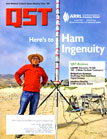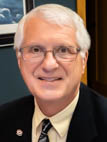
 |
|
|||||||||
|
|
 |
||||||||
 |
Classic Radio Column Restoring an Heirloom: The Gonset Twins by Mark Persons W0MH |
QST Magazine article August, 2021 Pages 93 and 94 |
|
||||||||||||
|
|
||||||||||||
|
Emails: 11-11-2021: GREAT ARTICLE. Mark, Enjoyed your article in August QST. What beautiful radios. Great job restoring them. Owen Heath, KB2QQM, Racine, Wisconsin. 09-06-2021: Hello Mark, Many thanks for your August 2021 Classic Radio article in QST on ďRestoring an Heirloom: The Gonset Twins.Ē Iím the son of Faust Gonsett who owned and operated the Gonset plant. Your article brought back so many good memories. As a kid, I may have touched the meters that wound up in your G-66B and G-77A. No, I wasnít the reason the paint fell off the pointers:) Best 73, Bob Gonsett, W6VR, Fallbrook, California.
08/05/2021:
Hello Mark. I am W7SCY and I was attracted to your article in the
August 2021 QST magazine primarily because it was about the "Gonset
Twins" because I had a Gonset Commander; but I was really surprised
to read that it was really about using the Gonset G77A transmitter
for a remote link to your father's radio station! I did the same
thing with a Johnson Viking II in the same time period (1958 or
1959) at KGAL in Lebanon, Oregon where I was Chief Engineer, and
have had hams doubt that the FCC would allow it.
We did a lot of remotes with our local radio station and they all
had to have telephone lines connected for a special hookup for our
"remote studio" with two turntables, three mike inputs and a small
mixer mounted into a small portable desk of sorts with folding
card-table-like legs that we could take to our station remotes. The
telephone lines were expensive, time consuming and a hassle. As an
active ham I discovered that we could license a radio link to KGAL
with a frequency that was very close to 10 meters (that must have
been 26.47 Mhz). We had acquired a British Morris van with a window
on one side to carry our equipment to the remotes, so I bought a
used Viking II, got it licensed for a broadcast link and installed
it in the van with the appropriate crystal (Vikings were crystal
controlled, with no VFO) a 10 meter whip on the side, the portable
studio mounted in the van and wired into the modulator of the
Viking. We had a ham receiver in the radio station wired directly
into an input of the main studio console to do live remote
broadcasts on the air. We painted the van with "KGAL: Radio on the
Go!" and put speakers on the top so visitors could hear the
broadcast and eliminated the hassle and cost of telephone lines for
remotes. All we needed was a 110 volt extension cord. The fidelity
was pretty low but it was a real innovation as, to my knowledge,
there were no studio-link radio systems available at the time. I
thought I had invented a new way of creating instant remote
broadcasts! It's great to hear that someone else had the same idea.
I am vindicated; the FCC did indeed license ham radios for broadcast
use!
About the Gonset Commander: it was strictly crystal controlled and I
had it mounted in my 1952 Ford but I only had one crystal for 3.840
Mhz. In 1958 I moved to Hollywood, CA to attend the Grantham School
of Electronics and acquire my FCC First Class Radio Telephone
License so I could be a broadcast radio engineer. When I found that
Gonset was nearby in Burbank, I called them up and found they had
manufactured an outboard VFO for the Commander but no longer made
it. However, they had one that was partially completed when they
shut down the production of them and I could have it with the parts
and diagram to finish it myself if I wanted. I drove right over
there and grabbed it, finished it and mounted it on the steering
column of my Ford. It had a simple tuned circuit and plugged into
the crystal socket of the Commander. It worked perfectly as long as
I had the Gonset. How many manufacturers would be that helpful
today?
I was in radio broadcasting for 35 years and evolved from
engineering into sales and management and spent the last 22 years
with the Radio Advertising Bureau. It was a lot of fun. I received
my Novice license, WN7SCY in July, 1951 so I celebrated 70 years of
continuous Ham radio fun with my original call (minus the "N") last
month. I'm active in the High Desert Amateur Radio Group (HiDARG),
the Central Oregon DX club and ARES and it's still fun!
Thanks for the trip down memory lane. 73, Bob Weed, W7SCY,
Bend Oregon.
07/28/2021: Enjoyed the Gonset Twins article. Mark, I ejoyed your article about the Gonset Twins in the August, 2021, issue of QST. From 1988 to 1997, I worked in Pittsburgh and lived east of Cleveland, Ohio. I used a Gonset G-66B to listen to on the two hour drive on Monday and Friday. I have the pair, but use a G-76 or Collins 32V-3 on AM. I am in Classic Radio often; I worked part time while in high school and college at ham radio stores selling and servicing equipment 1965 to 1974. 73. George Misic KE8RN, Allison Park, Pennsylvania. 07/18/2021: Ham Radio & QST Magazine. Hi Mark: Please allow me to compiment you on your truly excelent article about "The Gonset Twins." in the August issue of QST magazine. This is a terrific story with some very moving references to your dad As such, it brought back many nice memories for me too. 73, Dave Hughes WA3NFN, Huntsville, Alabama. |
|
Questions? Email Mark Persons: teki@mwpersons.com |
|
.